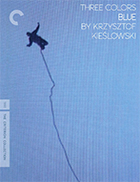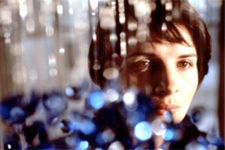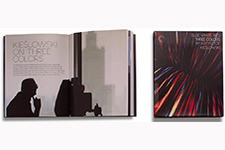| Director: Krzysztof Kieślowski | | Screenplay: Krzysztof Kieślowski & Krzysztof Piesiewicz | | Stars: Juliette Binoche (Julie Vignon), Benoît Régent (Olivier), Florence Pernel (Sandrine), Charlotte Véry (Lucille), Hélène Vincent (La journaliste), Philippe Volter (L’agent immobilier), Claude Duneton (Le médecin), Hugues Quester (Patrice), Emmanuelle Riva (La mere), Florence Vignon (La copiste), Daniel Martin (Le voisin du dessous), Jacek Ostaszewski (Le flutiste), Catherine Therouenne (La voisine), Yann Trégouët (Antoine) | | MPAA Rating: NR | | Year of Release: 1993 | | Country: France / Poland / Switzerland |  |
|  Blue (Bleu), the first entry in Polish filmmaker Krzysztof Kieślowski’s Three Colors (Trois couleurs) trilogy, explores a mourning woman’s desire to live without connection: no family, no friends, no work, no lovers, no emotional entanglements. But, most of all, she is trying to live without memory or history, to cut herself off entirely from her previous life and simply exist amid the flow of other people, but without ever connecting with any of them. The fact that she ultimately fails in her goal is testament to Kieślowski’s view of the fundamental interconnectedness of the world and the impossibility of being an island in the sea of human existence. The woman is Julie (Juliette Binoche), who at the beginning of the film is in a terrible car accident that claims the life of her young daughter and her husband, a famous composer who was working on a symphony to be played only once during the unification of Europe. After their deaths Julie attempts to cut all ties from her friends and family. She puts the family estate up for sale, gives away all of her possessions, destroys her husband’s unfinished compositions, and moves to an apartment in Paris where she hopes to effectively disappear. Julie’s desire to disconnect from the world poses a challenge for both Kieślowski as a filmmaker and Binoche as an actress because it means that the film is fundamentally about Julie’s internal world. Her interactions with other people are minimal and are defined primarily by her resistance to any contact, whether physical or emotional. When her lawyer asks if he can inquire why she wants to sell the family estate, her simple answer “No” is accompanied by a sly smile that suggests she is pleased with her increasing distance and the power it gives her. Her freedom is a “freedom from”—freedom from other people’s desires, freedom from other people’s problems, freedom from other people’s needs—but it is not a “freedom to” outside of being alone. Yet, she finds that, as much as she wants to disentangle herself from the world, the world is not so easily left behind, nor is memory, which intrudes on her at various moments in powerful, unsettling ways. Kieślowski settles on a fascinating aesthetic device to convey Julie’s memory: Whenever she is struck by a remembrance, we hear the striking chords of her husband’s composition and the screen fades to black for several seconds, effectively stopping time and shutting out everything else. We never see exactly what it is that she’s remembering, but it ultimately doesn’t matter. What does matter is that memory persists, even when we don’t want it to, because it is a constituent part of our existence. Sound also plays a crucial role in the film, and Kieślowski uses it in multiple ways. He underscores one of his favorite concepts, the idea that different people in different places might have the same idea simultaneously, by having a street musician playing Julie’s husband’s unfinished composition on his flute outside the café where she has coffee each morning. Kieślowski also emphasizes sound as experience throughout the film, giving us important information such as the opening car crash via sound, rather than image. Binoche’s performance is brilliantly understated, and she conveys with minimal dialogue and outward affectation a woman who is internally in turmoil. At every turn Julie is trying to repress her emotional instincts, and we sense the conflict she feels when others want to reach out to her and she has to resist any temptation to reach back (we are even led to doubt her complete commitment to isolation from her past because she refuses to throw away a blue-glass mobile that hung in her daughter’s bedroom). As much as she tries to cut herself off, faces both old and new enter her orbit and affect her in ways that she can’t quite dismiss. These include Olivier (Benoît Régent), a fellow composer who she briefly takes on as a lover before coldly dismissing him; Lucille (Charlotte Véry), a young woman who lives below her in the apartment and makes a living working in a sex club; Antoine (Yann Trégouët), the young man who witnessed her car wreck and was the last person to see her husband alive; and Sandrine (Florence Pernel), a woman who Julie discovers was her husband’s long-term mistress. Near the end of the film, when Julie has finally, reluctantly, gives up on trying to isolate herself physically and emotionally, Kieślowski stitches together a continuous, circling tracking shot that brings all of these characters together, suggesting simultaneously that each exists in his or her own sphere and yet are all interconnected, with Julie being the center point. We get the feeling that there is an infinite possible number of such shots, with each character being the center point for some other collection of people—a beautiful idea, indeed. Each of the films in Kieślowski’s Three Colors trilogy is built around one of the ideals in the French national motto—liberté, égalité, fraternité (liberty, equality, fraternity)—which are represented by the tricolor of the French revolutionary flag. In building Blue around the ideal of liberty, Kieślowski and his co-screenwriter Krzysztof Piesiewicz (with whom he also wrote the monumental TV mini-series The Decalogue) strip the term of its political connotations and instead fix it fully within the realm of the psychological and the emotional. Ironically, Julie’s self-imposed liberation from others becomes its own kind of prison, keeping her consistently on the margins of life. The choice of the color blue turns out to be all too meaningful, as the color has immediate connotations with coldness and melancholy, both of which are so deeply infused in Julie’s life, and yet have no outlet. When she sits in front of a roaring fire and voraciously devours a blue lollipop that reminds her of her daughter, we truly feel her desperation to consume and be rid of anything that might connect her with her past. As Kieślowski so beautifully demonstrates, that desire is ultimately futile because we are all interconnected in ways that we can never truly untie | Three Colors: Red Criterion Collection 4K UHD |  Three Colors: Blue is available exclusively as part of the six-disc “Blue White Red: Three Colors by Krzysztof Kieślowski” box set, which also includes Three Colors: White (1994) and Three Colors: Red (1994) on both 4K UHD and Blu-ray. Three Colors: Blue is available exclusively as part of the six-disc “Blue White Red: Three Colors by Krzysztof Kieślowski” box set, which also includes Three Colors: White (1994) and Three Colors: Red (1994) on both 4K UHD and Blu-ray. | | Aspect Ratio | 1.85:1 (all three films) | | Audio | French DTS-HD Master Audio 5.1 surround (all three films) | | Subtitles | English | | Supplements | Three Colors: Blue“Cinema Lesson With Director Krzysztof Kieślowski” featurette“On Blue” video essay by film studies professor Annette InsdorfVideo interview with Three Colors composer Zbigniew PreisnerSelected-scene commentary by actor Juliette Binoche“Reflections on Blue” featurette“Kieślowski: The Early Years” featuretteThe Tram (1966), a student short by KieślowskiThe Face (1966), a short starring KieślowskiOriginal theatrical trailer Three Colors: White “Cinema Lesson With Director Krzysztof Kieślowski” featurette“On White” video essay by film critic Tony RaynsVideo interview with cowriter Krzysztof PiesiewiczVideo interviews with actors Zbigniew Zamachowski and Julie DelpyShort documentary on the making of WhiteTwo short documentaries by Kieślowski: Seven Women of Different Ages (1978) and Talking Heads (1980) Original theatrical trailerThree Colors: Red “Cinema lesson with director Krzysztof Kieślowski” featurette “On Red” video essay by film writer Dennis LimVideo interview with actor Irène JacobVideo interview with producer Marin KarmitzVideo interview with editor Jacques WittaBehind-the-scenes footageShort documentary on the film’s world premiere at CannesKrzysztof Kieślowski: I’m So-So ... (1995) feature-length documentaryOriginal theatrical trailerInsert booklet featuring essays by film critics Colin MacCabe, Nick James, Stuart Klawans, and Georgina Evans; an excerpt from Kieślowski on Kieślowski; and reprinted interviews with cinematographers Sławomir Idziak, Edward Klosinski, and Piotr Sobocinski | | Distributor | The Criterion Collection | | Release Date | February 7, 2023 | | | COMMENTS | | Criterion originally released the three films in the Three Colors trilogy on Blu-ray in November 2011, and they looked great for that time. This new 4K UHD + Blu-ray box set includes all new restorations of the three films, starting with new 4K scans of each film’s original 35mm camera negative by MK2 and subsequent digital restoration. The restoration of Blue was performed under the supervision of cinematographer Sławomir Idziak,while the restoration of Red was supervised by cinematographers Piotr Sobociński Jr. and Michał Sobociński, the sons of the late cinematographer Piotr Sobociński. The restoration of White was done with reference to an archival 35mm theatrical print as a color reference. All three films in the Three Colors trilogy looks absolutely gorgeous, with substantial improvement over the previously available Blu-rays, especially when viewed using Dolby Vision HDR, which gives the films’ intense color schemes even more vibrant life. Criterion has delivered a trio of top-notch transfers that have Kieślowski’s final films looking better than they ever have, at least since their theatrical releases. All three films boast great contrast and detail, good depth, a fine veneer of grain to give them a pleasantly filmlike appearance, and absolutely gorgeous colors that are even more naturalistic and less manipulated than earlier releases. The blues, whites, and reds that dominate the respective films are appropriately cool, clean, and sensual. I can’t imagine the films looking much better on video. This box set also offers a big improvement in sound, with each film boasting a newly mixed DTS-HD 5.1-channel surround soundtrack created from the 35mm magnetic tracks (the Blu-rays feature two-channel surround tracks). Sound is a crucial element of Kieślowski’s films, whether it be the orchestral scores or the diegetic sounds that often provide as much, if not more, narrative and thematic information than the visuals. The soundtracks are clean and well defined and have an impressive robustness and sense of depth and immersion. All of the supplements from the 2011 Blu-ray box are included here. As befits a box set dedicated to the thematically and narratively interlocking films of the Three Colors trilogy, there are a series of repeating rhymes and patterns in the supplements for each of the three films. In lieu of an audio commentary, each film is given a 20-minute visual essay created in 2011 in which an esteemed film scholar examines its themes and aesthetics: Blue is covered by film studies professor Annette Insdorf, White is covered by critic and festival programmer Tony Rayns, while Red is covered by film critic Dennis Lim. Each of the three films also contains a “Cinema Lesson With Director Krzysztof Kieślowski,” which are short video pieces that apparently ran on French television around 1994. In each piece Kieślowski sits at an editing table and discusses in detail how he conceived and shot a particular scene from the respective film (the sugar cube sequence in Blue, the opening credits sequence in White, and Rita running away from Valentine in Red). Each disc also features each film’s original theatrical trailer, as well as video interviews (running an average of 19 to 20 minutes in length) with Kieślowski’s collaborators recorded in 2011 that shed light on both the production of each film and what it was like to work with the masterful director. On Blue we get an interview with composer Zbigniew Preisner, who has collaborated with Kieślowski on numerous projects since the mid-1980s, including The Decalogue and all three Colors films. The White disc contains an interview with co-writer Krzysztof Piesiewicz (who co-wrote all three films) and interviews with actors Zbigniew Zamachowski and Julie Delpy. And the Red disc features interviews with actor Irène Jacob, producer Marin Karmitz (who produced all three films), and editor Jacques Witta (who also edited Blue). Criterion also dug into the archives, giving us an impressive array of older material to help contextualize the films and shed some light on the entirety of Kieślowski’s career. The Blue disc features two student films from 1966, The Tram, which Kieślowski directed, and The Face, in which he starred, as well as several supplements from 2004 that, from what I gather, had not been available in Region 1 prior to Criterion’s 2011 box set. These include a selected-scene commentary by Juliette Binoche and two featurettes: “Reflections on Blue,” which runs about 18 minutes, and “Kieślowski: The Early Years,” which runs about 15 minutes. Both featurettes include interviews with actor Juliette Binoche, film scholar Annette Insdorf, film critic Geoff Andrew, filmmaker Agnieszka Holland, cinematographer Sławomir Idziak, actor Irène Jacob, and editor Jacques Witta. On the White disc we have two of Kieślowski’s short documentaries, Seven Women of Different Ages (1978) and Talking Heads (1980), as well as a brief making-of featurette from 1994 that features behind-the-scenes footage during the production of White. And, on the Red disc we also have a short behind-the-scenes featurette from 1994, a short documentary about the film’s world premiere at the Cannes Film Festival, and Krzysztof Kieślowski: I’m So-So ... (1995), a 55-minute documentary that is essentially a lengthy interview with Kieślowski at his home in Poland. It originally aired on Danish television and was completed less than a year before the director’s death. And, finally, the handsomely designed box set also includes a thick insert booklet that features essays by film critics Colin MacCabe, Nick James, Stuart Klawans, and Georgina Evans; an excerpt from Kieślowski on Kieślowski; and reprinted interviews with cinematographers Sławomir Idziak, Edward Klosinski, and Piotr Sobocinski. |
Copyright © 2023 James Kendrick Thoughts? E-mail James Kendrick All images copyright © The Criterion Collection |




 (4)
(4)

 Three Colors: Blue is available exclusively as part of the six-disc “Blue White Red: Three Colors by Krzysztof Kieślowski” box set, which also includes Three Colors: White (1994) and Three Colors: Red (1994) on both 4K UHD and Blu-ray.
Three Colors: Blue is available exclusively as part of the six-disc “Blue White Red: Three Colors by Krzysztof Kieślowski” box set, which also includes Three Colors: White (1994) and Three Colors: Red (1994) on both 4K UHD and Blu-ray.